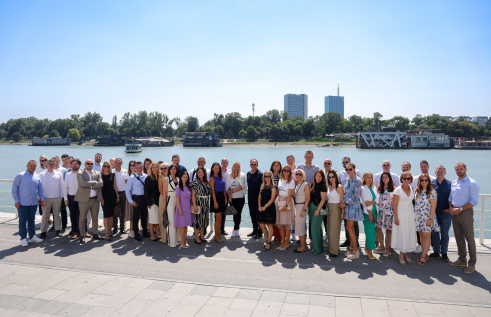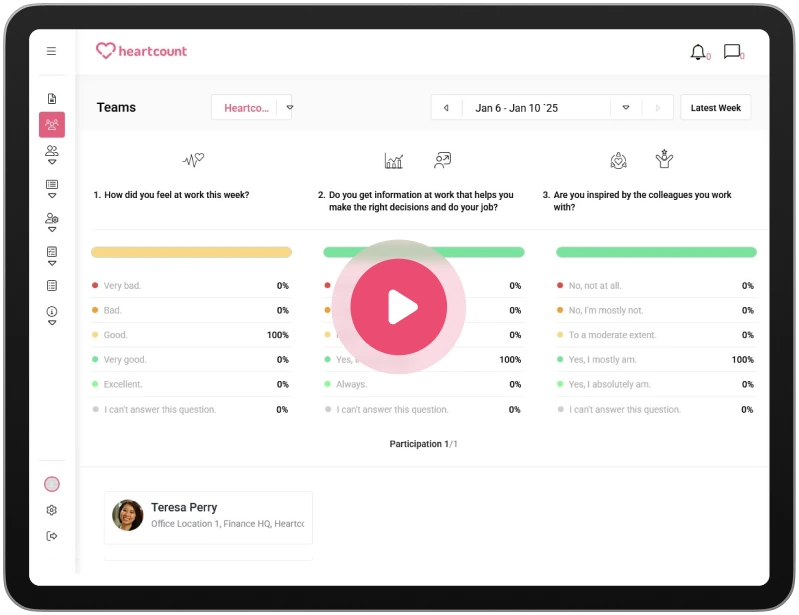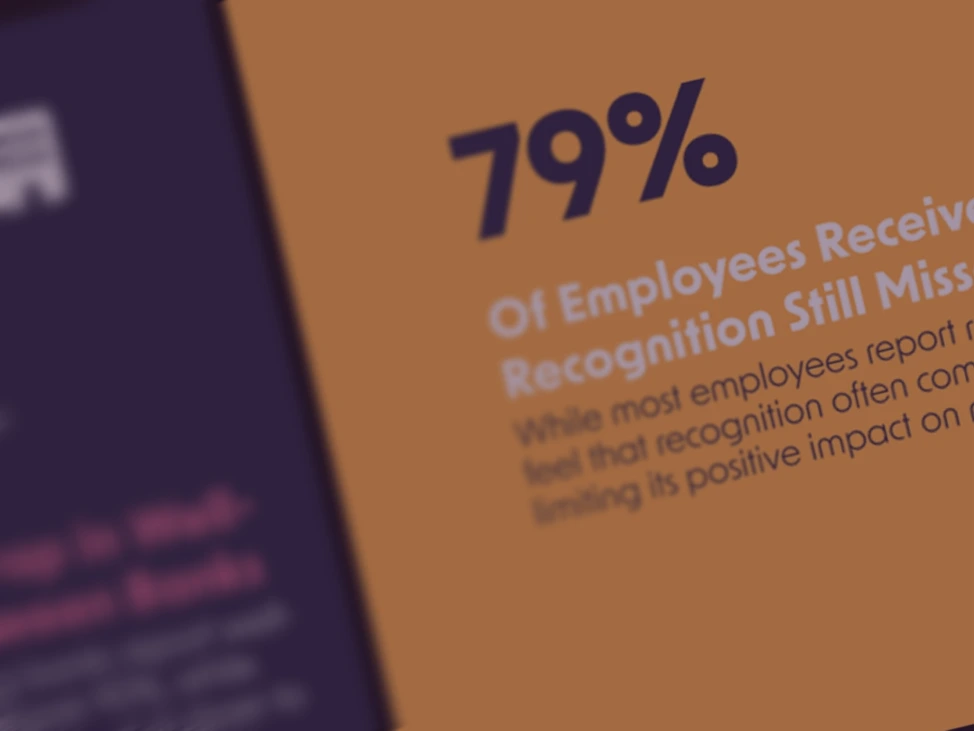Top 5 employee engagement trends in 2025

The business landscape is rapidly changing, and so are employee expectations. With the rise of remote and hybrid work, many employees now expect flexibility in their work schedules, which has been shown to increase job satisfaction and retention. There’s also a growing focus on mental health support, with more companies introducing wellness programs, counselling services, and stress management resources.
Companies that want to keep their employees, increase their productivity, and improve morale must be current and embrace new employee engagement trends.
Ignoring these trends can result in decreased employee engagement and higher turnover. Employees who don’t feel supported or valued are more likely to leave, causing companies to face the high costs of recruiting and training replacements.
The business landscape is rapidly changing, and so are employee expectations. With the rise of remote and hybrid work, many employees now expect flexibility in their work schedules, which has been shown to increase job satisfaction and retention. There’s also a growing focus on mental health support, with more companies introducing wellness programs, counselling services, and stress management resources.
Companies that want to keep their employees, increase their productivity, and improve morale must be current and embrace new employee engagement trends.
Ignoring these trends can result in decreased employee engagement and higher turnover. Employees who don’t feel supported or valued are more likely to leave, causing companies to face the high costs of recruiting and training replacements.
5 employee engagement trends for 2025
As we approach 2025, companies should be aware of important employee engagement trends to keep their workforce motivated and productive.
New ways of working, driven by technology and changing expectations, are restyling the workplace. Key trends like hybrid work models, AI in HR, mental health support, diversity and inclusion, and data-driven decision-making are gaining momentum.
Understanding these trends is important for improving employee satisfaction, boosting productivity, and ensuring long-term success.
1. Hybrid and flexible work models
Hybrid work models will continue to dominate as a trend in 2025, driven by the need for flexibility and employee preference for a balance between in-office and remote work. The COVID-19 pandemic accelerated the adoption of hybrid working, and studies have shown that employees are now accustomed to this flexibility.
For example, companies like Spotify have adopted a “Work from Anywhere” policy. Employees report feeling happier and more productive because they have the freedom to choose where they work. This flexibility has reduced burnout and increased job satisfaction.
According to reports from SHRM, businesses have realized that offering flexible work schedules improves productivity and job satisfaction.
Additionally, data from Gallup emphasizes that the hybrid model allows for greater employee engagement, as workers appreciate the autonomy to manage their work-life balance. Research also highlights that companies that embrace hybrid work can attract and retain top talent, especially as younger generations prioritize flexibility over traditional working conditions.
2. AI and automation integration in HR
AI and automation are predicted to revolutionize HR functions and workplace operations by 2025. AI’s role in HR has shifted from merely automating repetitive tasks to improving employee engagement and decision-making through advanced data analytics.
At Unilever, AI has made the hiring process much faster and more efficient. Thanks to AI, the time to hire has been reduced by 75%. HR managers now spend less time going through resumes and more time doing quality interviews with the best candidates. AI has also improved the quality of hires because it can analyze large amounts of data to find the most suitable people for the job. One of the biggest benefits is that AI helps increase diversity by reducing human bias during the initial stages of recruitment.
Leena AI reports that AI will personalize employee experiences, provide real-time feedback, and streamline administrative tasks like recruitment, onboarding, and performance management. This shift is supported by Marketing Scoop’s data, which shows that AI-driven tools improve the ability to gauge employee sentiment, thus helping companies better understand and address workforce needs.
However, the challenge lies in managing ethical concerns, such as bias in AI algorithms, which will be a key focus for HR professionals going forward.
3. Emphasis on mental health and employee well-being
Mental health and well-being are important concerns in modern workplaces, and they are set to remain a significant trend in 2025.
For instance, at Microsoft, employees are given “mental health days” to take time off to recharge. People who work there have said this helps them manage stress and feel valued by their company.
The pandemic shed light on the importance of mental health support, and businesses have since integrated wellness programs as a core part of their employee engagement strategies. Also, EY’s research highlights that companies that offer comprehensive mental health benefits, including access to counselling and wellness initiatives, see higher employee engagement and retention levels.
With remote and hybrid work creating new stressors, businesses are focusing on providing resources that help employees manage both their physical and mental well-being.
4. Advanced DE&I initiatives
Diversity, equity, and inclusion (DE&I) have moved from being compliance checkboxes to becoming central elements of workplace culture. By 2025, companies will be expected to create inclusive environments that go beyond surface-level diversity initiatives.
Salesforce is working hard to build a more inclusive workplace that better represents society. By 2030, they aim to make their workforce more diverse, transparent, and accountable. Currently, 45% of Salesforce’s global employees identify as women or non-binary, as well as 32% of their leaders. In the U.S., 20% of employees and 12% of leaders come from underrepresented minority groups. Salesforce uses data and regular updates to track their progress and make sure they continue improving.
Solutions Driven states that DE&I strategies are evolving to include continuous training, inclusive leadership, and policies that foster an environment where employees from all backgrounds can thrive.
Research from Gallup further supports the importance of DE&I, as diverse teams have been shown to perform better, drive innovation, and foster stronger employee engagement. DE&I will be essential in talent acquisition and creating inclusive policies that sustain engagement across diverse employee demographics.
5. Data-driven decision making
Data analytics is indispensable in shaping HR strategies, particularly in workforce planning and employee engagement. By 2025, data-driven decision-making will be critical for companies to optimize performance and create more effective HR policies.
Google uses data to constantly improve the workplace. Their People Operations team gathers employee feedback, with a 90% participation rate. Most decisions are based on data, which fits Google’s engineering culture, but HR is also about people, so they mix numbers with personal feedback using people analytics. This helps them understand the deeper parts of the company’s culture and improve productivity and employee satisfaction.
According to NetSuite, companies that use HR analytics tools to monitor engagement, predict turnover, and identify areas for improvement are better positioned to create supportive and effective work environments.
As AI and other technologies gather more data, HR professionals will need to improve their data literacy to make the most of these insights. Effective data use allows businesses to respond proactively to employee needs, improving retention and overall organizational performance.
Why is it important to track employee engagement trends?
Tracking the latest trends in employee engagement is necessary for any company that wants to remain competitive and successful. By understanding and adapting to what employees need and value, they can build stronger, more motivated teams that drive growth and innovation.
By monitoring employee engagement trends 2025, your company can:
1. Stay competitive
The business world is constantly changing, especially with the rise of technology, remote work, and shifting employee expectations. Companies that keep up with the latest employee engagement trends stay ahead by adapting to changes in how work is done and what employees value.
For instance, trends such as hybrid work models have been shown to increase employee satisfaction and engagement. According to a study by Gallup, organizations with engaged employees are 21% more profitable.
Ignoring these trends, however, can cause a company to fall behind, as disengaged employees are less productive and more likely to leave, which costs the company time and money in hiring replacements.
2. Address growing employee needs
Employees today expect more from their employers, such as flexibility, career development, and mental health support. These needs have shifted dramatically in recent years, especially due to the pandemic, which highlighted the importance of work-life balance and remote work options.
A FlexJob survey revealed that 58% of employees feel more committed when working remotely, and nearly 44% left or know someone who would leave their current jobs if forced to return to the office full-time.
By staying informed about engagement trends, companies can create environments that align with these changing needs and have a happier and more engaged workforce.
3. Improve retention and reduce turnover
Engaged employees are far more likely to stay with their current employer. When employees feel connected to their work and supported by their organization, they are less likely to seek other opportunities.
In fact, companies with highly engaged employees experience 43% less turnover than those with lower engagement levels. Turnover is costly—both in terms of recruitment and training and the loss of knowledge and experience.
By actively monitoring and adapting to the latest trends in employee engagement, companies can boost retention, which saves resources and nurtures a stable, experienced workforce.
4. Enhance productivity and innovation
Monitoring employee engagement trends is also important for boosting productivity and fostering innovation. Companies that invest in employee experience achieve 4x higher profits and 2x more revenue than other companies.
Engaged workers feel motivated and connected to the company’s mission, which leads to higher efficiency, better quality work, and increased ROI of employee engagement.
Increased engagement leads to a more innovative and dynamic workplace where employees are willing to contribute new ideas and work together to achieve the company’s goals.
5. Adapt to future challenges
Keeping an eye on the latest trends in employee engagement helps organizations stay prepared for future challenges.
- As technology advances, AI and automation are reshaping jobs and HR processes, forcing companies to rethink how they manage talent.
- Demographic shifts, like an ageing workforce and the rise of Gen Z, demand more flexible and inclusive work models.
- The growing importance of mental health and well-being adds another layer of complexity.
By proactively monitoring these changes, businesses can adapt and ensure they have the right strategies for future success.
How can these trends impact your workplace?
Tracking and adapting to employee engagement trends 2025 can transform your workplace culture, work structure, and employee experiences.
These trends go beyond engaging employees—they shape how companies operate and how employees feel about their roles.
Let’s explore the key impacts:
1. Transforming work structures
The rise of hybrid and flexible work models reshapes how work is structured. By offering employees the option to work remotely, companies can improve work-life balance and reduce stress.
Implementing hybrid work models creates a flexible environment that allows employees to be more productive and satisfied with their jobs. This new structure also allows businesses to hire talent from a global pool, no longer restricted by geographic location.
2. Creating a healthier organizational culture
Companies that prioritize mental health initiatives—such as stress management workshops, mental health days, and wellness programs—can expect happier, more engaged employees. Studies have shown that 89% of employees working in companies with wellness programs are satisfied with their jobs.
By normalizing mental health discussions and providing the necessary resources, companies create a supportive culture where employees feel cared for and valued.
3. Driving innovation
Adopting advanced DE&I strategies brings more innovation into the workplace. Teams with diverse backgrounds bring different perspectives, driving creativity and better decision-making.
By focusing on DE&I, companies cultivate a culture of inclusion where employees from all backgrounds feel welcomed and respected. This leads to higher employee engagement and stronger business outcomes.
4. Improving decision-making
By using people analytics, HR departments can track employee engagement levels, identify trends, and make informed decisions about areas that need improvement. This approach helps companies anticipate issues before they escalate, whether it’s turnover risks, productivity drops, or employee satisfaction dips.
Data allows organizations to be proactive in their engagement strategies, leading to more effective management and improved overall performance.
5. Building a future-ready workforce
Engaging employees through continuous learning and development is another major impact of these trends. Companies that focus on upskilling and reskilling their employees are better prepared for the future.
With technology and AI integration reshaping jobs, having a workforce that is equipped with the right skills will help businesses stay competitive. For example, the World Economic Forum predicts that 50% of all employees will need reskilling by 2025 due to technological advancements.
Encouraging continuous learning improves employee engagement and prepares them for future challenges, making the organization more adaptable.
Practical steps for adopting the latest employee engagement trends
To successfully integrate the latest employee engagement trends into your workplace, you need to take deliberate and strategic actions.
Practical steps include:
- Conduct employee surveys: Regularly conduct pulse checks via HR tools like HeartCount. Ask employees for their opinions about their work environment, management, and overall satisfaction. Their feedback will help you identify what’s working and what needs improvement and allow you to address concerns and boost engagement.
With HeartCount’s automated surveys, you can gain clear insights into eight categories of employee engagement weekly or biweekly.

- Implement AI tools: AI can help track employee sentiment by providing real-time feedback. For example, AI can monitor employee engagement through surveys or feedback tools, which helps managers respond more quickly to issues that might lower morale or productivity.
- Offer flexible and hybrid work models: Allowing employees to work from home part-time or offering flexible hours helps them balance their work and personal lives. Flexibility leads to happier, more motivated employees and can improve overall productivity.
- Introduce mental health programs: Offer resources like counselling services or workshops on stress management to show employees that their mental health is a priority. Support and recognition can reduce burnout and increase job satisfaction.
- Set clear DE&I goals: Establish clear DE&I goals, such as hiring more diverse talent and creating an inclusive work environment. Regular DE&I training will help employees understand the importance of inclusivity and make them feel more valued.
- Use data analytics: Collect and analyze employee engagement data, such as participation in programs or turnover rates. This information helps identify patterns and trends and allows making informed decisions to improve engagement.
With HeartCoutn’s advanced analytics, you can gain in-depth insights into team dynamics, identify any immediate concerns, and maintain momentum through weekly snapshots into employee engagement. These reports are always accessible and automatically updated on the platform.

- Regularly review and adjust engagement strategies: Continuously evaluate how well your engagement efforts are working by collecting feedback and measuring results. Based on this information, make adjustments to ensure strategies remain effective and relevant to your employees’ needs.
Stay on top of the latest trends in employee engagement with HeartCount!
Keeping up with employee engagement trends helps companies remain competitive, boost employee satisfaction, and enhance productivity. By adapting to these changes, businesses can create a supportive, innovative workplace that drives success and keeps employees motivated. Ignoring these changes can result in disengaged workers and high turnover rates, which are costly to any organization.
HeartCount helps you stay ahead of these trends by offering a real-time engagement tracking platform. It provides pulse checks and custom surveys that allow you to collect immediate feedback, measure employee sentiment, and analyze data to boost engagement.
Our tools also help identify factors that influence productivity and retention. Start your free trial today and optimize your engagement strategies with HeartCount!







